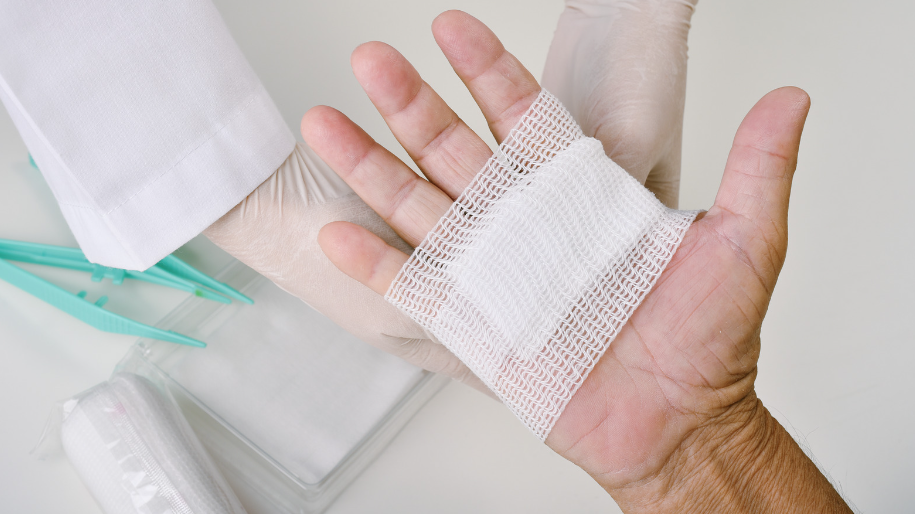Encountering wounds is an inevitable part of our daily lives, whether it’s a result of a tumble, a kitchen mishap, or simply breaking into new shoes. Despite their seeming insignificance, the importance of proper wound care cannot be overstated. Effective wound care not only prevents infections but also expedites the healing process. This blog delves into how you can learn wound care basics i.e. cleaning and dressing common injuries.
Phases of Wound Healing

Wounds progress through distinct phases as they heal. Initially, the body responds to injury with inflammation, characterized by heat, swelling, and pain. This stage is particularly susceptible to infection, although infections can arise anytime during the healing process.
In the second phase, the body begins rebuilding tissue at the wound site. Over time, new tissue forms, appearing sensitive and displaying shades of pink or red. This newly formed skin gradually toughens and thickens as the healing process advances towards its final stage.
Types of Wounds

Before delving into wound care techniques, it’s imperative to grasp the diversity of wounds.
Cuts and Scrapes
A cut is a wound that refers to an open split in the skin. It can be rough or smooth around the edges. Scrapes occur when the skin is rubbed off harshly or scraped away, exposing the inner layer of the skin. Symptoms that accompany cuts or scrapes include pain and bleeding.
Care Procedure
For cuts and scrapes, bleeding is typically minimal; however, if significant bleeding occurs, apply direct pressure until it ceases.
- If feasible, rinse the wound with clean, running tap water for at least five minutes.
- Inquire if the individual has any allergies to antibiotics, particularly penicillin, before suggesting the application of antibiotic ointment or cream to the wound.
- Cover the wound with a sterile, non-adhesive dressing and/or bandage.
- Ensure the individual is aware of the signs of infection and instruct them to monitor the wound for any such indications over the following days.
Discover essential techniques for stopping bleeding quickly in our latest YouTube short. Whether it’s a minor cut or a more serious injury, learn effective methods and tools that could make a crucial difference in emergencies. Watch now to equip yourself with life-saving skills that could help in unexpected situations.
Puncture Wounds
A puncture wound arises when a pointed object, such as nails, fragments of glass, or animal teeth, pierces the skin, creating a hole.
Common Causes of puncture wounds include but are not limited to injuries inflicted by sharp objects like nails or glass shards and animal bites.
Care Procedure
- If bleeding occurs, apply direct pressure until it halts.
- After achieving hemostasis, cleanse the wound meticulously with water. If available, rinse the wound for a duration of five minutes under clean, running tap water.
- Subsequently, cover the wound with a sterile dressing and/or bandage.
- Educate the individual about the importance of monitoring the wound for signs of infection in the coming days.
Infections

An infection arises when contaminants like dirt, foreign objects, or germ-laden materials enter a wound. These infections can manifest locally, confined to the site of the injury, or systemically, spreading throughout the body. Systemic infections often present with symptoms such as nausea, fever, or overall discomfort, potentially threatening one’s life.
Care Procedure
- Apply dressings to the wound and instruct the individual to hold them firmly to stem the bleeding.
- Use a bandage to secure the dressings in place.
- If you detect signs such as a soft spot or bone fragments, treat the injury as a head injury and apply direct pressure to the wound solely if the bleeding poses an immediate threat to life. Otherwise, attempt to manage bleeding by applying pressure around the wound area.
- Continue providing care until Emergency Medical Services (EMS) personnel arrive.
Burns
They can arise from exposure to heat, chemicals, electricity, or radiation. Their severity is classified into degrees, ranging from superficial to deep tissue involvement. Although the general care for all burns follows a similar protocol, specific steps may differ based on the burn’s cause. It’s crucial to remain vigilant for hypothermia, especially when cooling extensive burns, with particular attention given to children. If the individual reports feeling cold, cover them with a blanket to help maintain body warmth.
Master Wound Care Skills!
Join our Emergency First Aid (EFA) course specializing in wound care and learn how to effectively manage injuries in emergencies. Gain practical knowledge and confidence to provide immediate care when it matters most.
Cleaning Wounds

It is very important to clean the wound thoroughly before dressing it. If the wound is not cleaned properly, it may result in an infection or other complications, depending on the severity of the wound. Thorough wound cleaning is pivotal for eliminating dirt, bacteria, and debris to forestall infections. Here are the steps for effectively cleaning a wound:
- You must ensure that your hands are rinsed thoroughly with water and soap (if possible) and then dried off before touching the wound.
- You should place the wound directly under cool running water to clear it off of any lodged dirt. Do not use hot water, as that can damage the skin.
- After cleaning the wound with water, use a mild soap or saline solution to clean the area surrounding the wound, ensuring that no soap enters the wound.
- In the end, carefully pat the wound with a dry, clean, sterile cloth or gauze. Refrain from rubbing to prevent skin irritation and exacerbation of damage.
Guidelines for Bandaging

- Prioritize using clean, preferably sterile, dressings when bandaging wounds to minimize the risk of infection.
- Assess circulation below the injury before and after applying a bandage. If circulation appears compromised, loosen the bandage to ensure proper blood flow.
- In cases where blood seeps through the bandage, add additional dressings and apply another bandage on top. Ensure that the initial dressing is in contact with the wound without removal.
- To reduce the risk of infection, maintain cleanliness and dryness of dressings and bandages. As the wound begins to heal and bleeding is controlled, replace wet dressings with dry ones to promote optimal healing.
Register for First Aid Training
Learn the Wound Care Basics with Coast2Coast
Mastery of the fundamentals of wound care is indispensable for the efficacious treatment of common injuries and preventing complications. One can expedite healing while mitigating infection risks by comprehending the diverse array of wounds and adhering to proper cleaning and dressing protocols. In cases of severe or deep wounds, seeking medical attention is paramount. Always consult a healthcare professional if concerns regarding wound healing arise. With diligent care and attention, minor injuries can heal promptly and effectively, enabling a swift return to life’s activities.
At Coast2Coast, we offer comprehensive and detailed First Aid and CPR Training, which equips you to deal with treating and dressing common wounds and injuries. Join us in one of our various accessible training locations and be prepared for emergencies of any kind.



















